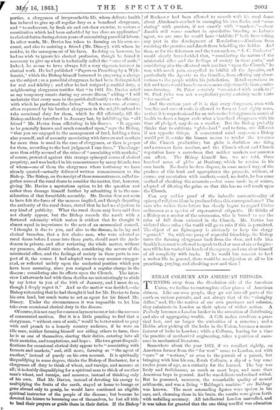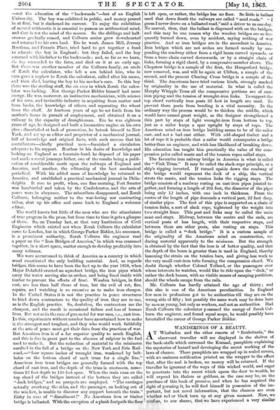ZERAII COLBURN AND AMERICAN BRIDGES.
TURNING away from the dissolution side of the American Union, we incline to contemplate other phases of American citizens. Like our own people, they go out into all parts of the earth on various pursuits, and not always that of the "almighty dollar," and, like the natives of our own provinces and colonies, they culminate in London as their sphere of widest action. A Peabody becomes a Loudon banker in the avocation of distributing and also of aggregating wealth. A Colt makes revolvers a prac- tical fact, and no longer the curiosities of a museum ; and a Hobbs, after picking all the locks in the Union, becomes a manu- facturer of locks in London ; while a Colburn, leaving for a time the practice of mechanical engineering, takes a position of emin- ence in mechanical literature.
Somewhere about the year 1812, if we recollect rightly, an American farmer from the "far west" came to London, not with " corn " or "notions," or even in the pursuit of a patent, but bringing with him his son, Zerah Colburn, a slip of a boy some twelve years of age, as a curiosity for the learned. The boy was lively and frolicksome, as much as most boys, and more than American boys in general. And he was delicate and refined withal. But he possessed, moreover, the remarkable quality of mental arithmetic, and was a living " Babbage's machine" ere Babbage was known. The most astounding figures were spoken in his ears, and, churning them in his brain, the results were given forth with unfailing accuracy. All intellectual London marvelled, and it was taken for granted that the one thing needful was education —not the education of the "backwoods "—but of an English Univereity. The boy was exhibited in public, and money poured In at first, but it slackened its current. To enjoy the exhibition
of mental arithmetic it is essential to possess an arithmetical mind, and that is not the mind of the masses. So the shillings and half-
crowns gradually ceased, and Colburn senior grew downhearted and returne I to his own land. Ere he went, Jams Mill, Jeremy Bentham, and Francis Place, tried hard to get together a fund to educate the boy in England ; but they failed, and the boy
returned with his father to the backwoods ; and, so far as we learn, the boy succeeded to the farm, and died on it at an early age.
But there was another member of the Colburn family, an uncle of Zerah the calculator, who left a son behind him, who in turn gave a nephew to Zerah the calculator, called after his name,
and then died, leaving the boy to his mother's care. In this boy there was the sterling stuff, the via viva in which Zerah the calcu-
lator was lacking. Not George Parker Bidder himself had more energy. He was, moreover, an instinctive mechanician, with science of his own, and invincible industry in acquiring from matter and from books, the knowledge of others, and separating the wheat from the chaff. At fourteen years of age he set forth from his mother's home in pursuit of employment, and obtained it on a railway in the capacity of draughtsman. Ere he was eighteen years of age, he designed and built a locomotive engine on his own plan ; dissatisfied at lack of promotion, he betook himself to New York, and sat up as editor and proprietor of a mechanical journal, full of knowledge and original facts, with such success that his contributors—chiefly practical men—furnished a circulation
adequate to his support. Restless in his desire of knowledge and
looking on England as a fountain-head, he disposed of his paper and made several journeys hither, one of the results being a publi- cation of considerable merit upon the railways of England and America, and another, the editorship of the best mechanical periodical. With his added mass of knowledge he returned to America, and established a practical mechanical journal in Phila- delphia It rose to profit, when, one fine morning, Fort Sumter was bombarded and taken by the Confederates, and the arts of peace were in abeyance. The subscribers disappeared, and Zerah Colburn, belonging neither to the war-loving nor contracting tribes, shut up his office and came back to England a welcome editor.
The world knows but little of the men who are the stimulators of true progress in the press, but from time to time it gets a glimpse of them. So, on Tuesday last, at that very Institution of Civil Engineers which existed not when Zerah Colburn the calculator came to London, but in which George Parker Bidder, his successor, is a prominent authority, Zerah Colburn the engineer read a paper on the "lion Bridges of America," in which was crammed together, in a short space, matter enough to develop profitably into many volumes.
We were accustomed to think of America as a country in which wood constituted the only building material. And, as regards bridges, this seems to have been the fact up to the year 1858, when Major Delafield erected an aqueduct bridge, the iron pipes which carry the water serving also as arches, and being lined inside with timber to prevent the effects of frost. Wooden bridges, in first cost, are less than half those of iron, but the evil of rot, fire, repairs, and watching is so excessive as to make iron cheaper.
In the United States it is not the practice in peace structures to bind down contractors to the quality of iron they are to use, as is the English practice. So, doubtless, the contractors use the cheapest, and the result is occasional failure and loss of human lives. But not so in the case of gun metal for war uses, 2.e., cast iron. In this, experiments without number have ascertained how to make it the strongest and toughest, and they who would work faithfully
at the arts of peace must get their data from the practices of war. But American iron is of a far superior quality to much English, and this is due in great part to the absence of sulphur in the fuel used to make it. But the reduction of material to the minimum
resulted in the fall of a bridge on the New York and Erie Rail- road,—" four square inches of wrought iron, weakened by bolt- holes on the bottom chord of each truss for a single line." American iron truss bridges are generally formed with the top chord of cast iron, and the depth of the truss is enormous, some- times 23 feet depth to 120 feet span. When the train runs on the top chord of the bridges instead of the bottom they are called "deck bridges," and no parapets are employed. "The carriages actually overhang the sides, and the passenger, on looking out of the window, is unable to discover any support beneath the train."
Risky in Case of "ffiarailment !" No American iron or timber bridge is ballasted. With the exception of a plank footpath the floor
is left open, or rather, the bridge has no floor. So little is ballast used that down South the railways are called "mud roads." I guess I never drove on a ballasted road," said a driver to us one day. No marvel, then, that the ballast is dispensed with on the bridges, and this may be one reason why the wooden bridges are so fre- quently burned down, even by accident, saying nothing of war practice. And so iron bridges are in the ascendant in America. Iron bridges which are not arches are formed usually by sus- pending the roadway either from a rigid beam curved upwards, or from a loose chain curved downwards, or by a straight chain of links, forming a rigid chord, by a compressive member above. The Chepstow bridge is a sample of the first, the Hungerford bridge, now removed, was, and will be again at Clifton, a sample of the second, and the present Charing Cross bridge is a sample of the third. The Americans have tried various kinds, strongly marked by originality in the use of material. In what is called the Murphy Whipple Trams all the compressive portions are of cast- iron piping and the tension of wrought-iron links. To support the top chord vertically iron poste 23 feet in length are used. To prevent these posts from bending is a vital necessity. In the ordinary way the process would be to thicken the middle, which would have caused great weight, so the designer strengthened a thin part by stays of light wrought-iron from bottom to top, just as a sailor keeps a spar upright by stays of rope. 1 he American mind on iron bridge building seems to be of the sailor cast, and not a bad cast either. With odd-shaped timber and a lot of rope it is probable that a sailor would extemporize a bridge better than an engineer, and with less likelihood of breaking down. His education has taught him practically the value of the com- preesion poles called masts and of the tension ropes called stays.
The favourite iron railway bridge in America is what is called the "Fink Truss." It may be called the slack-rope principle, or a ship's rigging inverted. If turned upside down the roadway of the bridge would represent the deck of a ship, the vertical struts the masts, and the tension links the rigging stays. The bridge consists of a roadway resting on cast.iron pipes jointed to- gether, and forming a length of 205 feet, the diameter of the pipes being only 12 inches, with one inch in thickness. From the centre of the length of pipe descends a vertical post, 22 feet deep, of similar pipes. The foot of this pipe is supported on a chain of tension links, a sort of slick rope, tightened by the weight into two straight lines. This post and links may be called the main mast and stays. Midway, between the centre and the ends, are vertical posts of less length, with their respective stays, and between them are other posts, also resting on stays. This bridge is called a 4' deck bridge." It is a curious sample of the originality of the American mind on construction, re- ducing material apparently to the minimum. But the strength is obtained by the fact that the iron is of better quality, and that the depth of the beam is greater than is used in England, thereby lessening the strain on the tension bars, and giving less work to the very small cast-iron tube forming the compression chord. We doubt though whether Colonel Yolland, or the passengers over whose interests he watches, would like to ride upon the "deck," or rather the deck beams, with no visible means of escaping perdition, should the wheels escape from the rails.
Mr. Colburn has hardly attained the age of thirty ; and this also is one of the American peculiarities. In England few men in professions gat to be authorities till they are on the wrong side of fifty ; but possibly the same work may be done here by men as young, but only as workers, and not as authorities. Had Zerah Colburn the calculator possessed the energy of Zerah Col- burn the engineer, and found equal scope, he would possibly have forestalled the career of George Parker Bidder.































 Previous page
Previous page